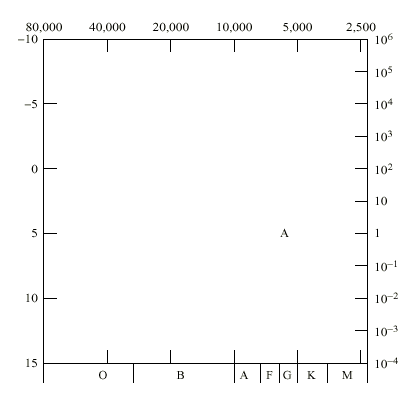
Your name:
Your ID:
Please show your working on this sheet, and write your answers on this sheet. Attach extra sheets if you need them.
1. Parallax
As of today (24 Sep 2000) there are 58 confirmed planets or brown dwarfs known around main sequence stars other than the Sun. The latest data can be found in the Extra-solar Planets Catalog.
To date the nearest star with a planet is e Eridani (HD 22049), the 6th nearest star system beyond the Sun and the a Cen triple system. e Eri is 0.8 times the mass of the Sun, and the planet is 1.2-4.7 times the mass of Jupiter, with a 6.9 year period. The Hipparcos satellite measured a parallax ( http://astro.estec.esa.nl/Hipparcos/table361.html) of 0.31075 ± 0.00085 arcseconds (the ± number is the uncertainty in the measured parallax). What is the distance to e Eri? For 1 point extra credit, figure out also the uncertainty in the distance, and write your answer as x ± y parsecs.
e Eri is ______________________ parsecs away from us.
2. Inverse Square Law
h+c Persei is a pretty double open cluster of stars which can be seen with binoculars in the northern sky. A main sequence A star (just like Vega or Sirius) appears in h+c Persei to be 15 magnitudes (= a factor of 106) fainter than Sirius. The distance to Sirius is known from its parallax to be 2.63 parsecs away. How far away is h+c Persei, in parsecs? [Hint: use the inverse square law of distances. You can assume that Sirius and the A star have the same luminosity.]
h+c Persei is ______________________ parsecs away from us.
3. Main Sequence Fitting
The Hyades and the Pleiades are two of the best-known open star clusters. The Hyades star cluster is the V-shaped system of stars about 10 degrees to the right and upward from the Orion constellation, about half way between Orion and the Pleiades. Historically, determining the distance to the Hyades cluster has been a crucial step up the Cosmic Distance Ladder. Its distance turns out to be about 40 parsecs away. The main sequence in the Pleiades appears about 2.5 magnitudes (= a factor of 10) fainter than the main sequence in the Hyades. How far away is the Pleiades cluster?
The Pleiades cluster is ______________________ parsecs away.
4. HR Diagram
Below is the beginnings of an HR diagram. Complete the labeling of the axes (Which is surface temperature? Which is spectral type? Which is luminosity? Which is absolute magnitude? What are the units in each case?). Here is a list of stars with their spectral types and absolute magnitudes. The number on each spectral type is the subtype within the spectral type. The subtypes run from 0 to 9, with 0 being hottest, 9 being coolest.
| Star | Spectral Type | Absolute Magnitude | |
| A | Sun | G2 | 5.0 |
| B | Rigel Kent (a Cen A) | G2 | 4.34 |
| C | a Cen B | K4 | 5.70 |
| D | Proxima Cen (a Cen C) | M5 | 15.45 |
| E | Barnard's Star | M5 | 13.24 |
| F | Sirius A (a CMa) | A1 | 1.45 |
| G | Sirius B | A5 | 11.5 |
| H | Betelgeuse (a Ori) | M2 | -5.14 |
| I | Rigel (b Ori) | B8 | -6.69 |
| J | Arcturus (a Boö) | K1 | -0.31 |
| K | Capella (a Aur) | G8 | -0.48 |
| L | Vega (a Lyr) | A0 | 0.58 |
| M | b Cen | B1 | -5.42 |
| N | Procyon A (a CMi) | F5 | 2.68 |
| O | Procyon B | F | 13.1 |
| P | Kapteyn's star | M0 | 10.89 |
| Q | Deneb (a Cyg) | A2 | -8.73 |
| R | e Eri | K2 | 3.73 |
Plot the stars on the HR diagram. I already plotted star A as an example. Indicate on the diagram which stars are on the main sequence, which stars are red giants, which stars are supergiants, and which stars are white dwarfs.

5. Stefan-Boltzmann Law
Sirius, the brightest star in the sky bar the Sun, is actually a binary system. Sirius B is 10 magnitudes (factor of 104) fainter than Sirius A, but Sirius B's surface temperature is about twice that of Sirius A. What is Sirius B's radius relative to that of Sirius A?
The radius of Sirius B is about ______________________ times the radius of Sirius A.